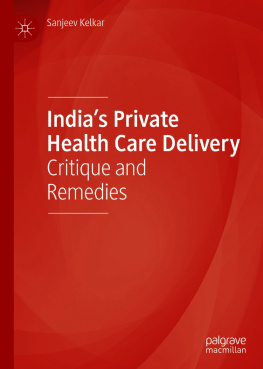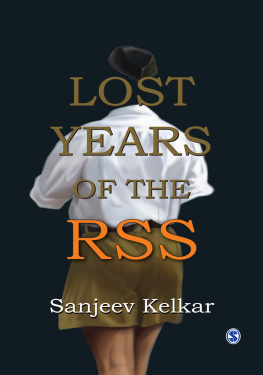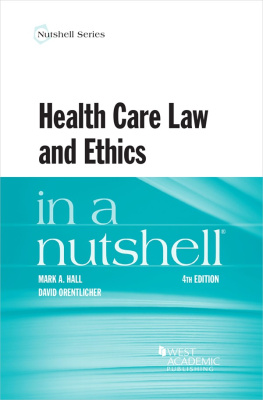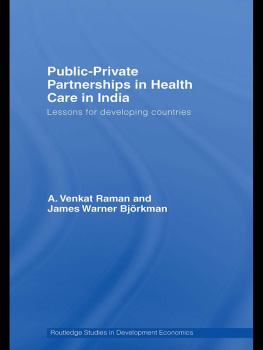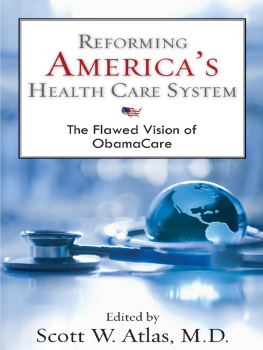Sanjeev Kelkar
Indias Private Health Care Delivery
Critique and Remedies
1st ed. 2021

Logo of the publisher
Sanjeev Kelkar
Pune, Maharashtra, India
ISBN 978-981-15-9777-0 e-ISBN 978-981-15-9778-7
https://doi.org/10.1007/978-981-15-9778-7
The Editor(s) (if applicable) and The Author(s), under exclusive license to Springer Nature Singapore Pte Ltd. 2021
This work is subject to copyright. All rights are solely and exclusively licensed by the Publisher, whether the whole or part of the material is concerned, specifically the rights of translation, reprinting, reuse of illustrations, recitation, broadcasting, reproduction on microfilms or in any other physical way, and transmission or information storage and retrieval, electronic adaptation, computer software, or by similar or dissimilar methodology now known or hereafter developed.
The use of general descriptive names, registered names, trademarks, service marks, etc. in this publication does not imply, even in the absence of a specific statement, that such names are exempt from the relevant protective laws and regulations and therefore free for general use.
The publisher, the authors and the editors are safe to assume that the advice and information in this book are believed to be true and accurate at the date of publication. Neither the publisher nor the authors or the editors give a warranty, expressed or implied, with respect to the material contained herein or for any errors or omissions that may have been made. The publisher remains neutral with regard to jurisdictional claims in published maps and institutional affiliations.
This Palgrave Macmillan imprint is published by the registered company Springer Nature Singapore Pte Ltd.
The registered company address is: 152 Beach Road, #21-01/04 Gateway East, Singapore 189721, Singapore
Dedicated to
(Late) Professor V S Ajgaonkar, my first teacher during my postgraduate years
Professor R D Bapat, the humanist surgeon from Mumbai
Preface
The most relevant and basic questions regarding private health care sector are: What were the ideas the private health care delivery had to start with? How did more ideas appear and how has private medical care in India evolved? What is its place in the total context of health and people? How has it changed the larger social, economic and political situation and Indias health care delivery over the last 50 years? How many reasonable and relevant solutions has it offered to satisfactorily solve health issues ? That is to say, have these ideas and workings resulted in a health care delivery system by making it accessible, affordable, high quality and endowed with equity and justice? How many challenges has it addressed efficiently or how many new challenges has it created for good or for ill? And finally, what is the balance between benefits and injury caused to health care?
These questions have an added dimension today in mid-May 2020 of the Covid-19 pandemic and the destruction it has caused worldwide, including in India. The final manuscript of this volume went into the pre-publishing process in the second week of February 2020. The Covid-19 lockdown started on March 25, 2020. I considered it essential to have a brief overview of the Covid-19 situation and assess the role, contribution and relevance of private health care in India vis a vis Covid-19. Sectors such as pharmaceuticals have considered this an unprecedented, once-in-a-lifetime opportunity to make money (see below). For me it was a lifetime opportunity to test the many elements, observations, shortcomings and other injurious effects of the private sector, as well as its contribution to the fight against Covid-19. It is also a lifetime opportunity for me to weigh the measures suggested by me with respect to the private sector regarding its current suitability and effectiveness. In my 49 years in medicine I have never found the health system of any country prior to 2020 in such great difficulties.
Covid-19 as a Disease as Such
Covid-19 has given rise to many controversies and accusations on the global scale which we will discuss before turning to India. Is it a biologically present virus which for various reasons has spread across the world at an alarming speed causing diabolical destruction or is it a virus created in a laboratory by China with a view to destroy the global economy and to gain economic and hegemonic supremacy over the world as a whole and Western economies in particular? At the World Health Assembly in May 2020, 123 nations asked for an investigation into China and its role in the WHO; the accusations of China destroying early evidence of Corona has lent this scenario a sinister dimension. Why did it spread along the 40 latitude so rapidly with devastating results in Europe, particularly in Western nations such as Italy, Spain, France, Germany and the US, where an enormous number succumbed very quickly? None of these nations were particularly keen on lockdown initially, even vacillating over it, and they have paid the price. Why did it then spread to South America with Brazil becoming the new epicenter, and then other nations such as Australia and countries in Africa later than this, breaking the 40 N latitudinal boundaries? What were the reasons for the initial deaths being confined to older people, or the high numbers of African Americans and then scale-down to the younger population later?
What are the pathological mechanisms which have caused these deaths? Why is it taking so long to flatten the curve of infections and deaths after such a long period of months? How long is it going to stay with us, or is it a permanent feature of our environs? One answer has been given for this question by Dr Shailendra Mundhada, a pathologist whose Dhruv Lab is the only private lab in Nagpur India, with permission from the National Board of Laboratory Accreditation to test samples. He says that it will enter into a differential diagnosis like SARS 2 or H1N1 in severe respiratory infections in a short while. Like other viruses its infectivity will go down, Dr Madhavi Deshmukh of Dhruv Labs stated (Mundhada and Deshmukh 2020). Dr Randeep Guleria, Director of the All India Institute of Medical Sciences, also stated on DD News on May 18, 2020 that the recovery rate will be nearly 90%, which in some ways supports these possibilities (Guleria Randeep, Dr Director AIIMS, May 18, 2020, DD News).
For selecting the private labs to test Covid-19, the National Accreditation Board for Testing and Calibration Laboratories (NABL) accreditation is the criterion the government has laid down for private labs to test Corona samples, while the government labs within public health care have been allowed to carry out testing without this quality check. This is somewhat odd since the test is delicate, needs careful handling from collection to the report stage. A chain of ten individuals is needed to conduct tests in a day (Mundhada and Deshmukh 2020). Thus the possibility of false negative tests may surface more particularly in government labs and the numbers reported so far could be higher, although these are already quite high. One fact has stood out with respect to the high-quality private sector setupsthese have not come forward to test samples, probably because they did not want patients to come to them who could be positive. This is not an entirely valid reason since such a setup could easily have been made available at a distance from the entry gate of their hospital blocks to collect the swabs.

